Louis XV Style: When France Invented the Art of Living
The Louis XV style revolutionizes Western art by substituting grace for grandeur, intimacy for pomp. This aesthetic transformation reflects the profound evolution of 18th-century French society: from the Versailles court to Parisian life, from royal ceremony to bourgeois comfort. The French rococo becomes the first truly international style, copied from Saint Petersburg to Naples.
This silent revolution transforms our modern conception of luxury and refinement. The Louis XV curves still draw our ideal of French elegance today, from the bergère to the writing desk, from tea salons to palace suites.
Louis XV: The Creative Explosion of French Rococo
This extraordinary period, marked by fifty years of decorative innovation, definitively transforms European art and imposes new standards of refinement.
Decisive Chronology:
• 1723-1774: Reign of Louis XV (51 years)
• 1730-1760: Apogee of French rococo – revolution of forms
• Worldwide influence: Age of Enlightenment, enlightened bourgeoisie
The Revolution of Grace
This era overturns all the codes of Louis XIV decorative art. The artist-decorator emancipates himself from the royal framework, while the Parisian bourgeoisie becomes the prescriber of European taste.
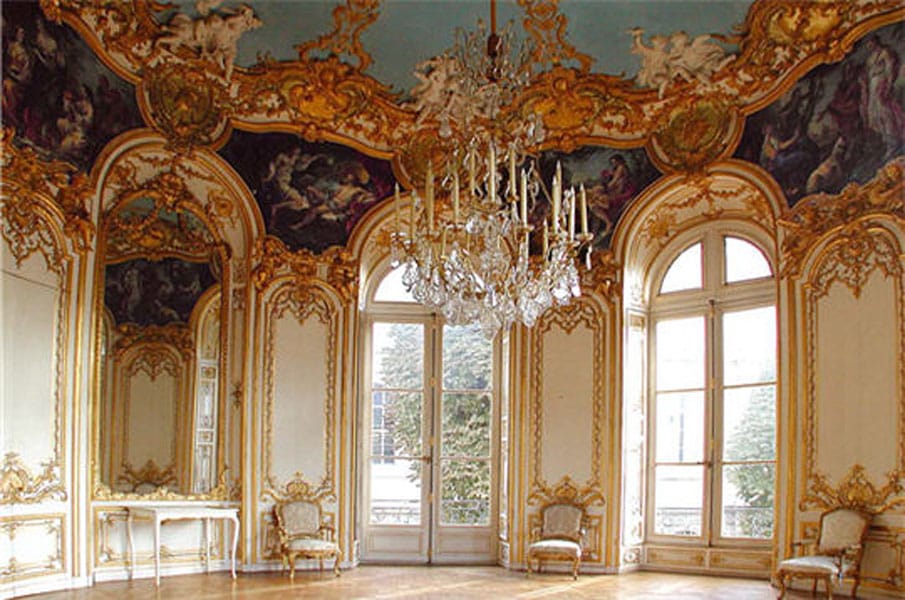
Charles Cressent, Jean-François Oeben, Juste-Aurèle Meissonnier embody this creative revolution that definitively transforms Western art.
The emergence of salon society revolutionizes lifestyles. Conversation, music, reading inspire an art that celebrates refined intimacy and domestic harmony.
This social transformation engenders an unprecedented aesthetic that still influences our contemporary vision of French comfort and elegance.
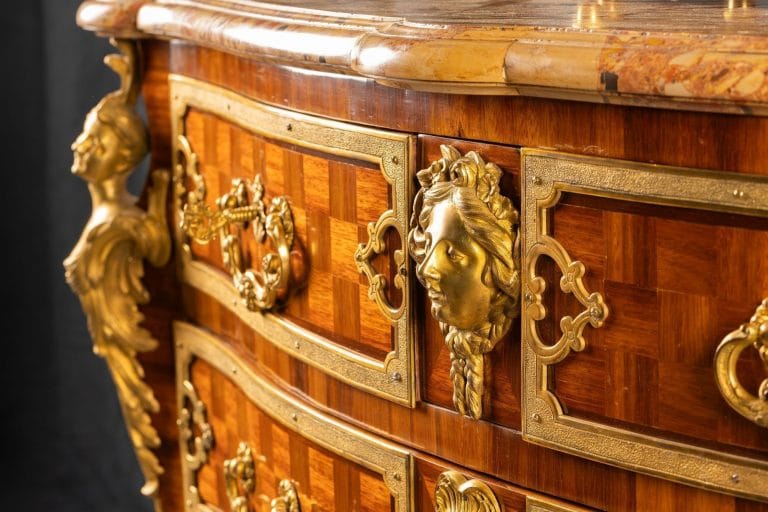
Revolution of Form and Curve
It is now the artist-cabinetmakers who invent modern aesthetics, replacing Louis XIV geometry with visionaries of curves and asymmetry.
This era invents the revolutionary alliance between art and comfort, beauty and functionality, democratizing the refined art of living.
Louis XV aesthetics abolishes the frontier between utility and beauty: sensual curves, precious marquetry, chased bronzes testify to a hedonistic modernity.
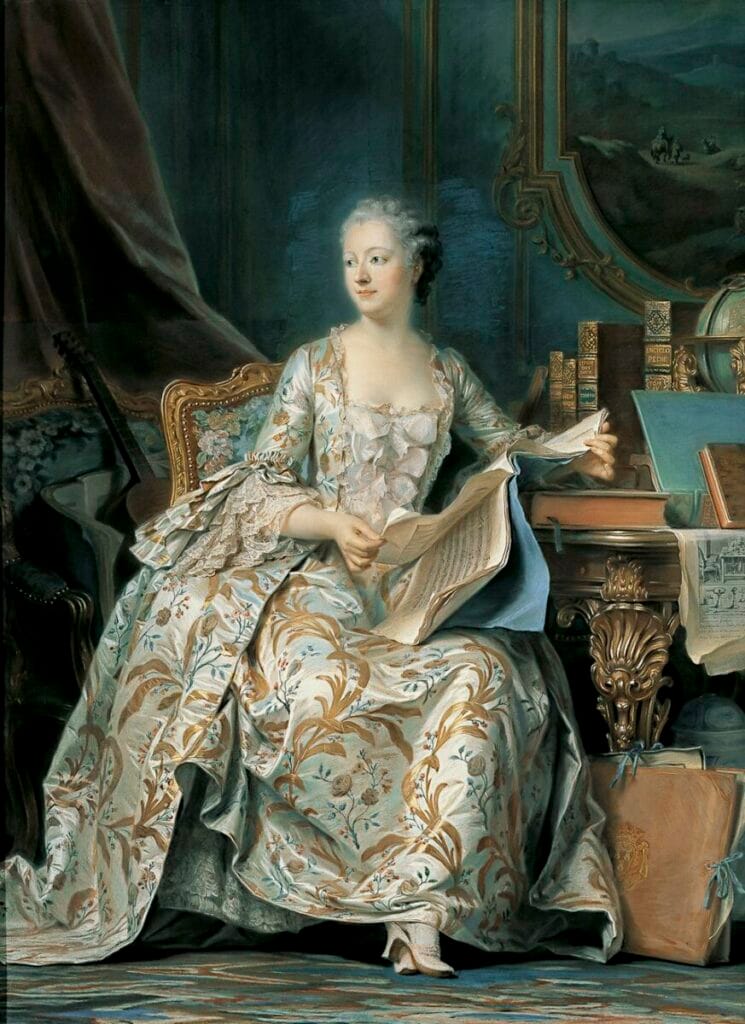
Arts: The Avant-garde of Refinement
Paris and Europe, Laboratories of Taste
Parisian decorative art of the 1730-1760 period synthesizes all European innovations in a style of revolutionary coherence.
Charles Cressent (master of rococo cabinetmaking), Jean-François Oeben (virtuoso of mechanisms), Jacques Dubois (innovator of forms) define this new aesthetic.
Juste-Aurèle Meissonnier revolutionizes ornamentation, François Boucher transforms decorative art, while Antoine Watteau explores poetic potentials.
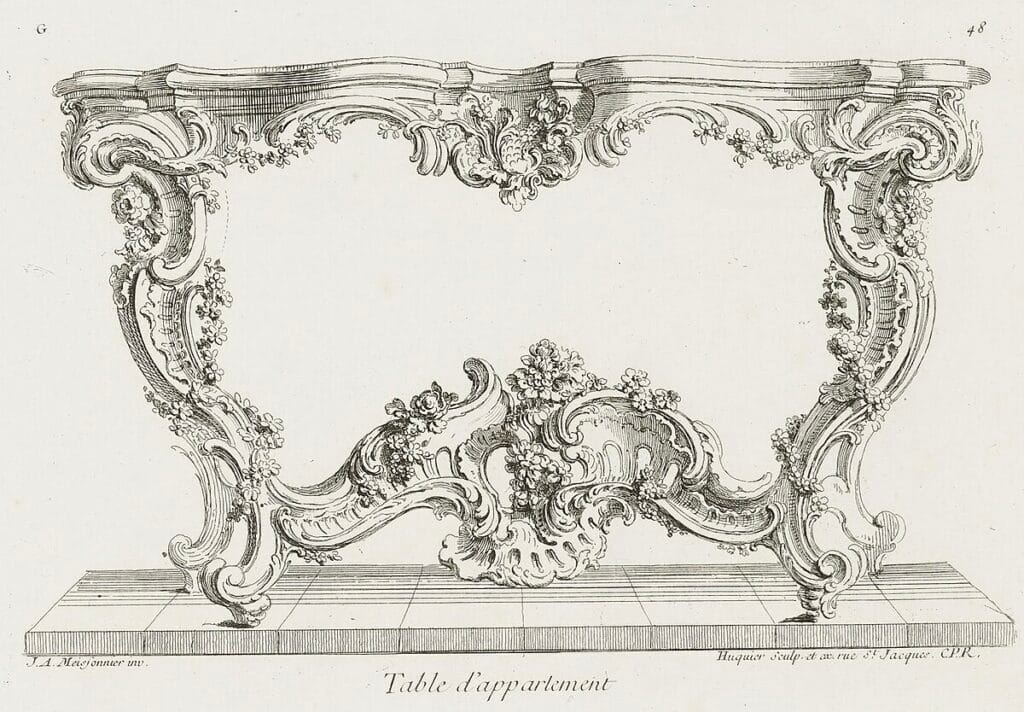
The Renaissance of French Art Crafts
The Louis XV style spectacularly revitalizes all French art crafts by freeing them from symmetrical constraint and orienting them towards formal innovation.
Charles Cressent (virtuoso of cabinetry without crossbars), Jean-François Oeben (master of secret mechanisms), Pierre II Migeon (innovator of commodes) reinvent their art.
Bronze workshops modernize with Jacques Caffieri and Philippe Caffieri who create an ornamental language of unequaled delicacy.
Goldsmithery reaches new heights with Thomas Germain and François-Thomas Germain, while the Sèvres manufactory transforms porcelain into refined art.
Decorative sculpture revolutionizes with Jean-Baptiste Oudry, Étienne-Maurice Falconet and Jean-Antoine Houdon who develop a graceful language of new sensibility.
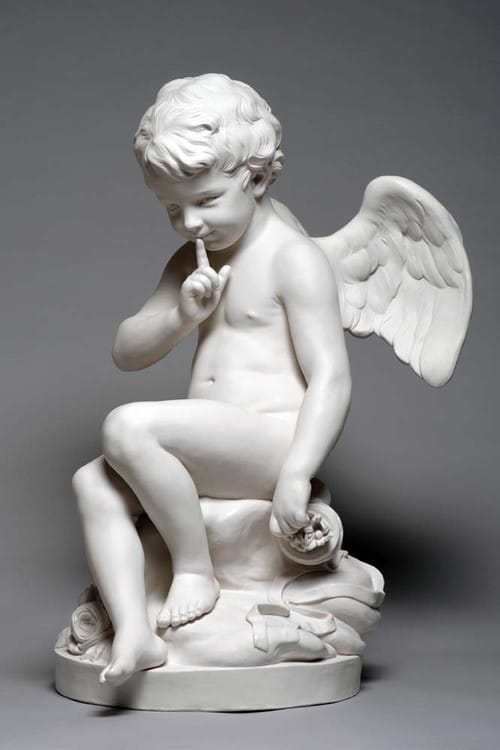
Louis XV Architecture: Manifesto of Intimacy
The Private Mansion as Laboratory: Innovation of Comfort
The Founding Event: The Parisian private mansion transforms architecture into a manifesto of modern art of living.
This unprecedented revolution imposes new architectural canons: functional distribution, convenience apartments, revolutionary society salons.
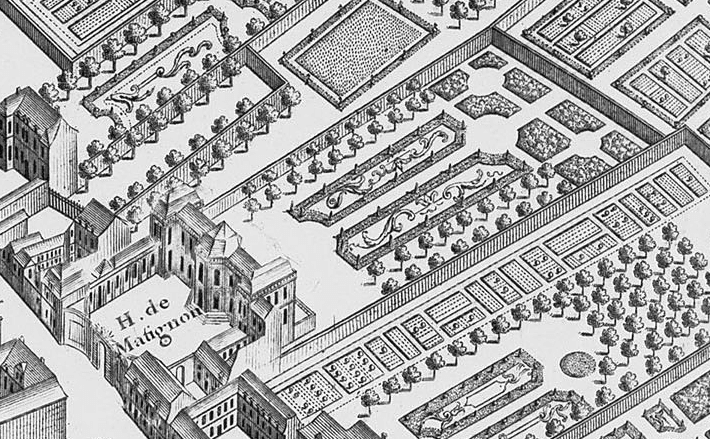
Permanent achievements (Hôtel de Soubise, Military School, Place Stanislas) definitively inscribe refinement in the French landscape.
This aesthetic revolution transforms the international image of France and influences European architecture for decades.
Masters of French Architecture
Architect Germain Boffrand, creator of rococo architecture, develops a decorative aesthetic that influences all European architecture.
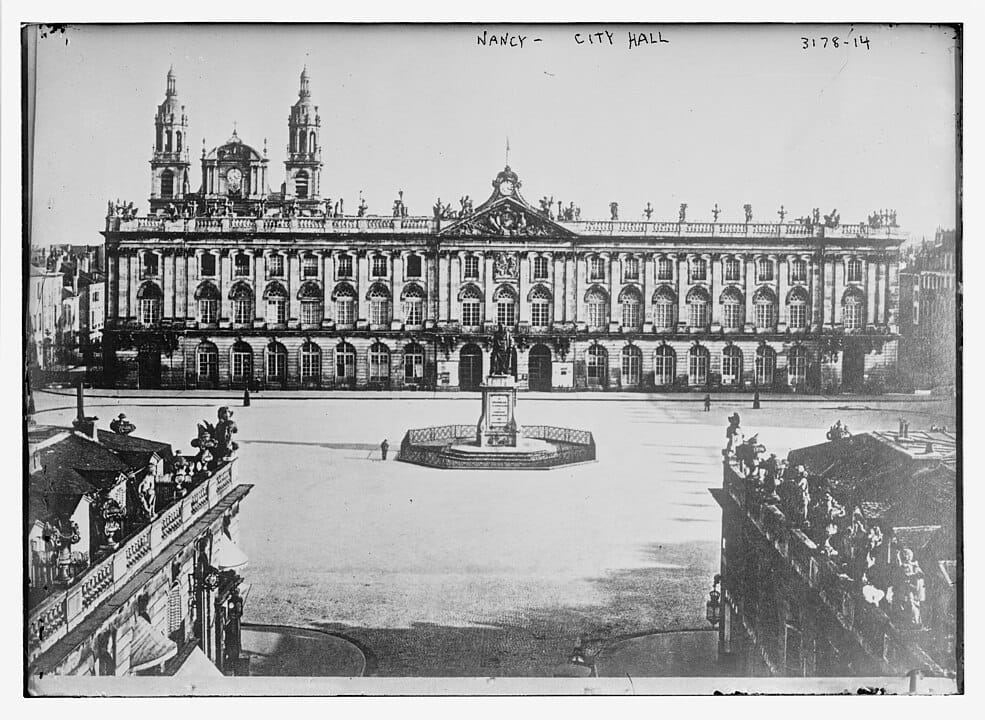
Ange-Jacques Gabriel (creator of French neoclassical architecture), Emmanuel Héré (master of rococo urbanism and architect of Place Stanislas), Jean Courtonne (innovator of distribution) embody this French avant-garde.
This architectural school, internationally celebrated, establishes the foundations of modern art of living and inspires European capitals.
It revolutionizes our conception of refined habitat and permanently imposes French elegance as a worldwide aesthetic reference.
Total Decorative Art
The Louis XV style invents the concept of art of living where architecture, furniture, art objects and textiles form a harmonious ensemble serving comfort and beauty.
Creators Charles Cressent, Jean-François Oeben, Juste-Aurèle Meissonnier develop the art of decorative synthesis.
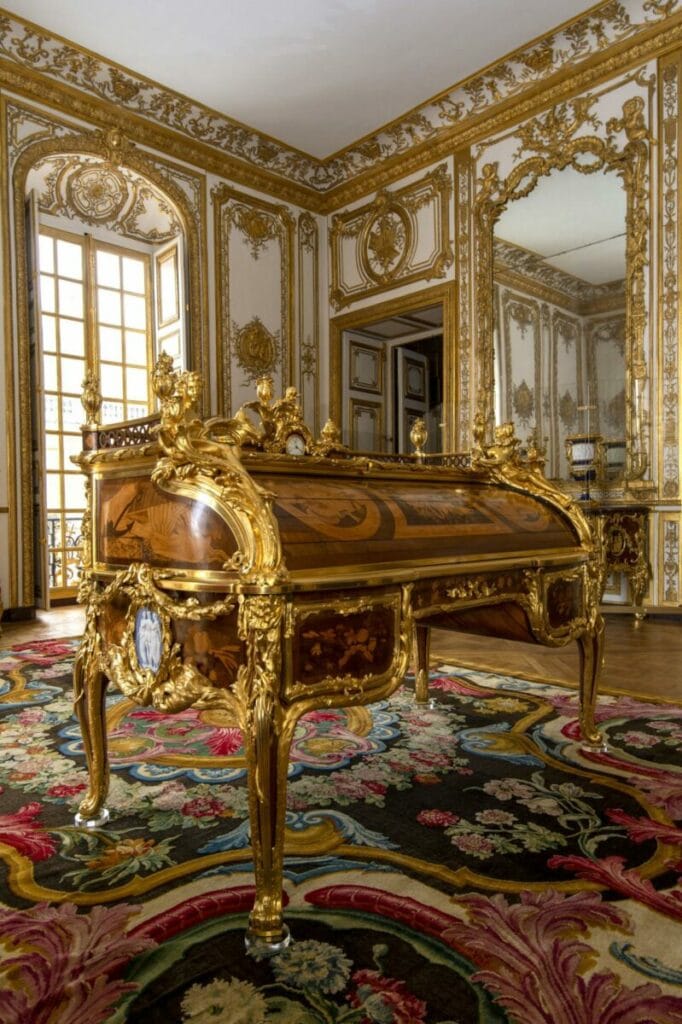
The Synthesis of Arts
The Louis XV style codifies a universal decorative vocabulary that transcends borders: asymmetrical rocaille, refined chinoiseries, gallant pastoral.
François Boucher (master of decorative painting), Jean-Baptiste Oudry (virtuoso of still life) revolutionize applied arts through their colorist innovations.
The influence of Far Eastern art and French tradition introduces a refined exoticism that radically renews European inspiration.
The furniture arts are reborn with the bronze workers Caffieri, the cabinetmakers of the Faubourg Saint-Antoine, creators of objects of seductive refinement.
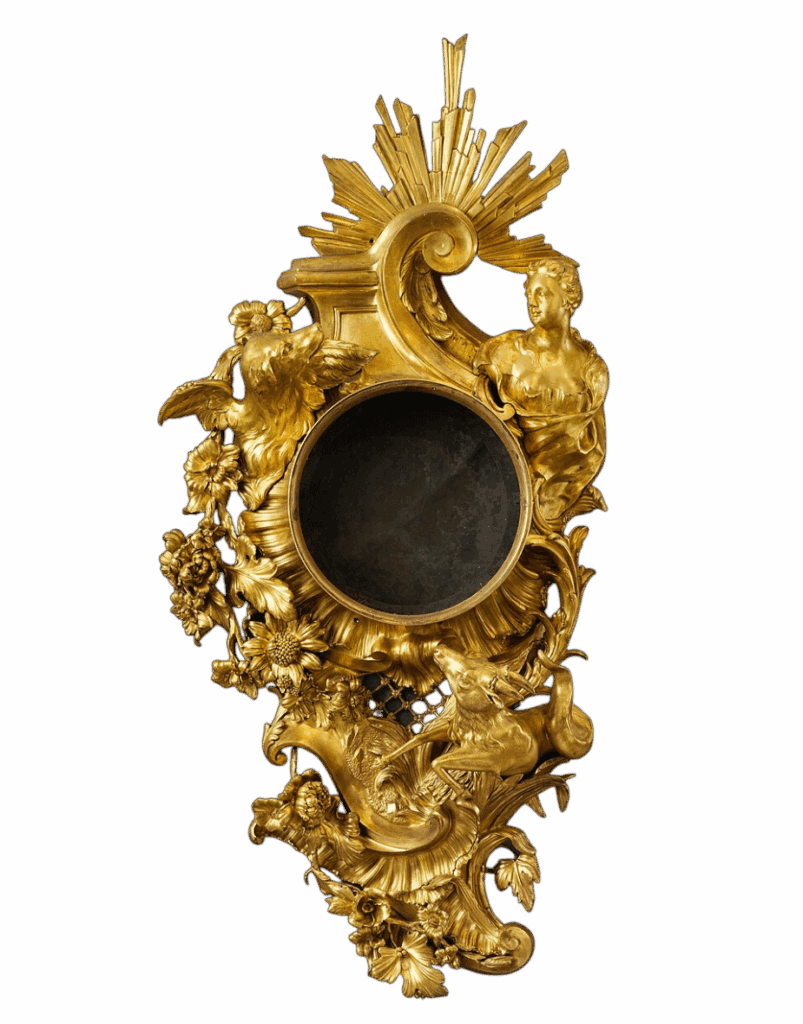
Porcelain finds new breath with the Sèvres manufactory which develops a table art of exceptional delicacy.
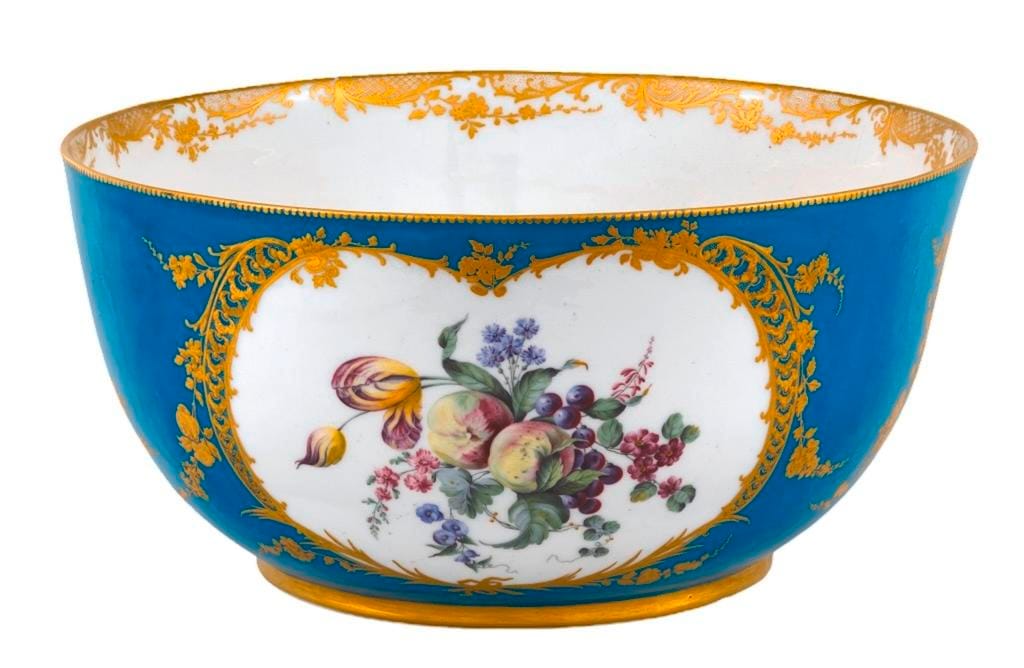
The workshops of Charles Cressent (revolutionary cabinetmaking), Jacques Caffieri (furniture bronzes), François-Thomas Germain (refined goldsmithery) establish new European standards.
Cressent’s furniture, Caffieri’s bronzes, Lyon silks create an art of living of refined sophistication.
Graceful asymmetry, precious materials, elegant functionality characterize this aesthetic of hedonistic modernity.
The apartments of Madame de Pompadour, decorated by François Boucher, perfectly embody this decorative revolution where French art meets daily aristocratic intimacy.
Louis XV Furniture: The Invention of Modern Comfort
Material Revolution:
The Louis XV style radically transforms the use of materials by privileging tactile beauty and visual seduction in unprecedented syntheses.
This revolutionary approach creates an aesthetic of absolute refinement that still influences contemporary luxury furniture.
Creators privilege precious species (rosewood, violet wood, amaranth) for their chromatic beauty, sublimated by poetic marquetries.
The art of marquetry reaches unequaled heights: flower marquetry, landscapes, still lifes create decorative effects of revolutionary delicacy.
The major innovation lies in the harmonious integration of secret mechanisms: springs, hidden drawers, clockwork mechanisms revolutionize furniture aesthetics.
Formal Revolution:
Louis XV furniture invents modern comfort by reconciling sculptural beauty and refined functionality.
This innovative approach revolutionizes the art of furniture and establishes the foundations of contemporary luxury design.
Inspiration draws from international art: German rococo, chinoiseries, Turkish art nourish a cosmopolitan creativity.
Ergonomic and aesthetic research enriches this vocabulary: body studies, psychology of comfort, art of conversation inspire a hedonistic aesthetic.
The ingenuity of master cabinetmakers develops a furniture typology of revolutionary refinement, adapted to the new uses of Parisian society.
Louis XV interiors are characterized by their sophisticated grace and functional comfort, prefiguring our contemporary conceptions.
Louis XV Style Fabrics: The Art of Rococo Textiles
Materials and Textures: The Revolution of Touch
The Louis XV style revolutionizes textile art by privileging tactile sensuality and chromatic richness. French manufactories develop unprecedented techniques that transform textiles into major decorative elements.
Lyon Silks:
Lyon silks reach their technical apogee with complex façonnés and moiré effects of unequaled sophistication. Brocaded silks integrate gold and silver threads to create revolutionary chatoyant effects.
Silk damask:
Damasks develop relief patterns that play with light, creating decorative effects of exceptional visual richness.
Genoa Velvet:
Italian velvets, particularly appreciated, offer a tactile depth and changing reflections that harmonize perfectly with gilded bronzes.
Painted fabrics:
Indian fabrics and Jouy fabrics (although appearing around 1760) introduce narrative and exotic motifs that renew decorative inspiration.
Colorist Palette: The Invention of Rococo Colors
The Louis XV colorist revolution creates an unprecedented palette that still influences our perception of French refinement.
Signature colors:
- Pompadour Pink: Created specifically at Sèvres around 1757, becomes the emblematic color of the era
- Turquoise Blue: Technical innovation from Sèvres, adapted to textiles to create total decorative harmony
- Celadon Green: Inspired by Chinese porcelains, establishes itself in furnishing silks
- Nankin Yellow: Exotic color that testifies to the influence of Asian art
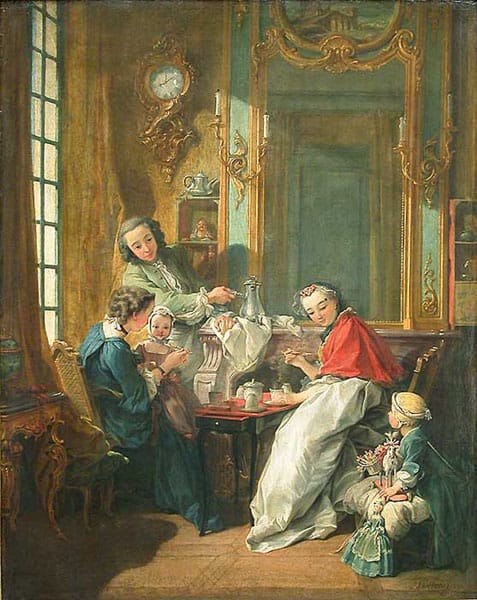
Sophisticated harmonies:
Louis XV colorist associations privilege delicate camaïeux: pink and gray, blue and white, green and gold create ambiances of refined sweetness.
Motifs and Iconography: The Rococo Vocabulary
Louis XV textile ornamentation develops an iconographic repertoire of unequaled poetic richness.
Natural motifs:
- Flower bouquets: Roses, peonies, tulips treated with graceful naturalism
- Garlands and festoons: Asymmetrical compositions that embrace furniture curves
- Rocaille motifs: Shells, corals, stylized cascades in the rococo spirit
Pastoral scenes:
- Gallant shepherdesses: Inspired by paintings of Watteau and Boucher
- Chinoiseries: Pagodas, mandarins, exotic birds testify to the craze for the Far East
- Gallant festivities: Scenes of idealized aristocratic life
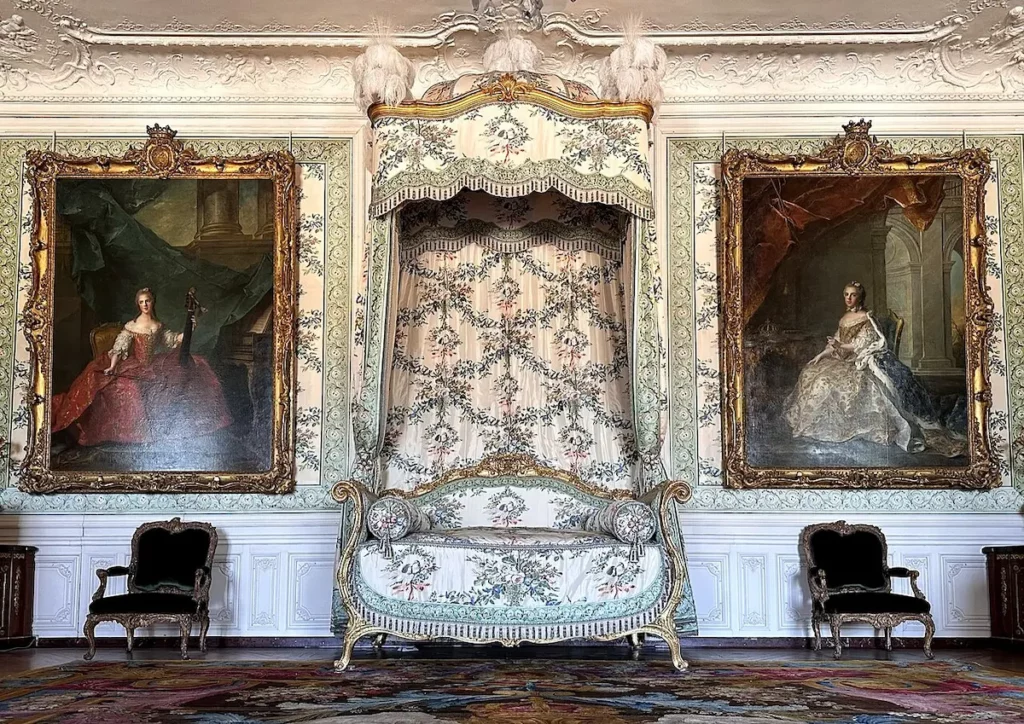
Furnishing Applications: Specificities by Use
Chairs and upholstery:
Beauvais tapestries dominate prestige furnishing with their narrative compositions and refined colorings. Chairs adopt specific fabrics according to their function:
- Bergères: Plain silks or delicate damasks to highlight bronzes
- Salon chairs: Tapestries with floral or pastoral motifs
- Sofas: Genoa velvets or brocaded silks for ceremonial pieces
Hangings and curtains:
Wall hangings rival woodwork in rococo decorative art. Lyon silks create monumental effects with their large floral patterns.
- Casement curtains: Silk damask with symmetrical motifs
- Door curtains: Velvets enhanced with gold braids
- Bed canopy: Fashioned silks in tender colorings
Cushions and trimmings:
The art of the passementier reaches its apogee with sophisticated creations:
- Rococo braids: Asymmetrical motifs in gold thread
- Tasseled fringes: Mobile ornaments that amplify movement
- Cords and tiebacks: Functional elements transformed into decorative jewels
Techniques and Savoir-Faire: French and European Excellence
Fashioned weaving:
Lyon looms develop revolutionary techniques allowing complex effects:
- Lampas: Mixed warp/weft technique for subtle reliefs
- Brocade: Integration of metallic threads for luminous effects
- Pekin: Chatoyant stripes that play with light
Dyeing and colors:
French master dyers revolutionize the textile palette:
- Cochineal: For deep reds and delicate pinks
- Indigo: Perfect mastery of blues, from sky to turquoise
- Weld and quercitron: Stable and luminous yellows
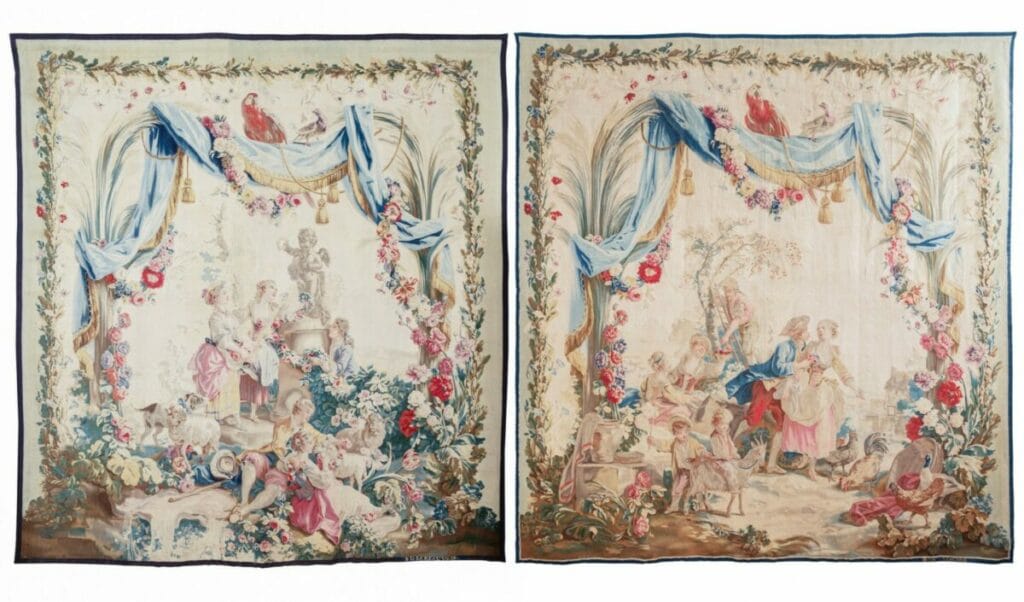
Evolution and Influences: Towards Transition
Around 1760, Louis XV textiles evolve under the nascent influence of neoclassical taste:
- Simplification of motifs: Progressive return to symmetry
- Antique inspiration: First motifs of palmettes and meanders
- More sober colors: Anticipation of the Louis XVI palette
This textile evolution accompanies the transformation of taste that leads towards Transition style then Louis XVI, testifying to the adaptability of French industry.
Louis XV Furniture Typology: The Art of Refined Living
Seating: Revolution of Comfort
Specialized Creations: An Unprecedented Typology
The inventiveness of the era is revealed in the diversity of creations: the Marquise, small personal sofa for the boudoir; the Ottoman, large bench without backrest of oriental inspiration; the Duchesse Brisée, modular meridienne in several elements; the Voyeuse for observing card games, and the Voyelle, astride seat for players. Each creation responds to a precise social use, testifying to the extreme refinement of aristocratic manners.
Technical innovation: The caning fashion, appeared around 1715, brings its freshness to Versailles summers. Beds also evolve: disappearance of spindle beds, appearance of the Polish-style bed and the Turkish-style bed, testimony to Ottoman influence on French decorative art.
The Louis XV seat revolutionizes the art of sitting by reconciling modern ergonomics and sculptural beauty in creations of unequaled formal grace.
Decorative innovation harmoniously integrates sculptures, fluting and gilding in compositions of striking delicacy. Bergères adopt enveloping volumes and precious upholstery of exceptional comfort. The salon seat diversifies with specialized creations that accompany new uses of sociability.
The adoption of anatomical curves and technical padding radically transforms the French seating tradition.
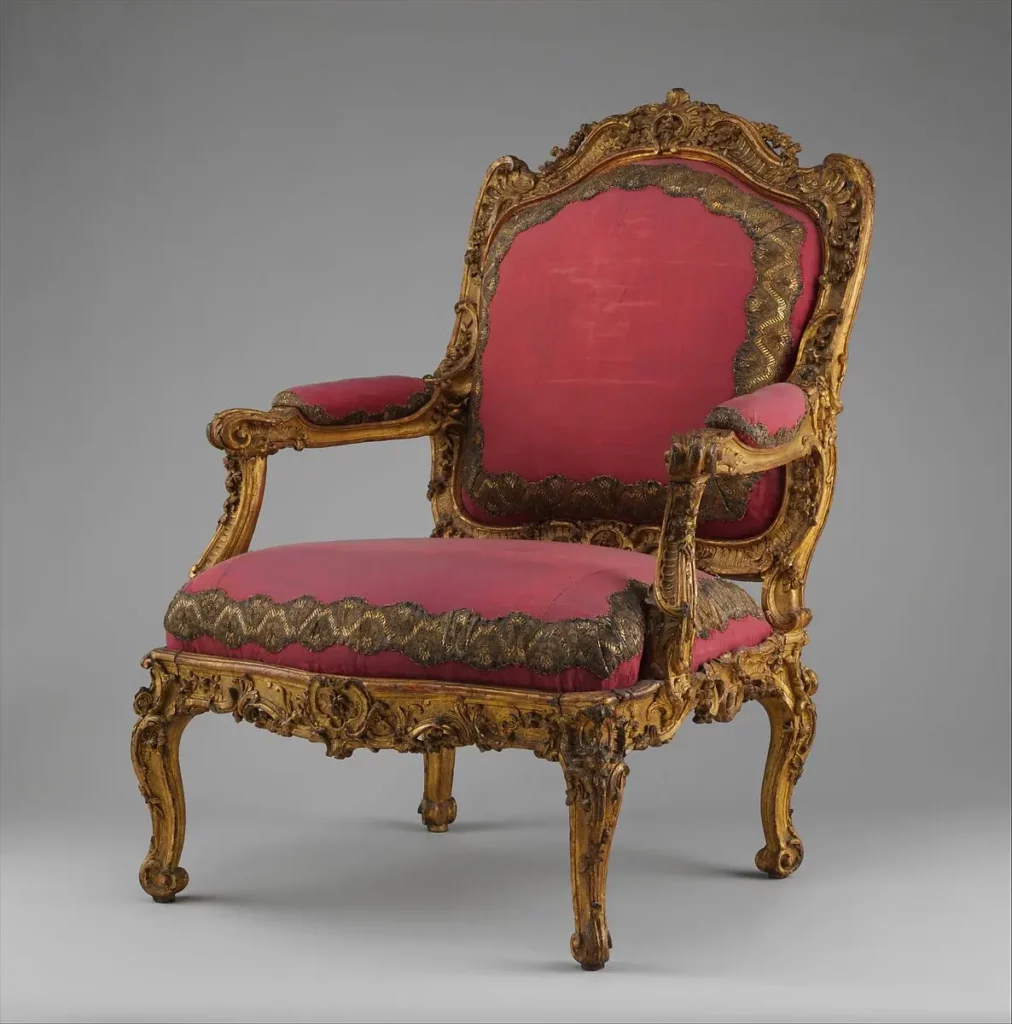
The use of removable frames for seat upholstery (seats, backrest and even armrest sleeves!) develops to be able to change fabrics according to seasons. Have you noticed that this is the case with the armchair below? Observe carefully, all these upholsteries are removable.
The Fauteuil à la Reine: Ceremony in Majesty
The fauteuil à la reine embodies the etiquette and pomp of Louis XV’s court. Recognizable by its high and flat backrest, it imposed a straight and dignified posture, symbol of power and status. Designed for great ceremonies and placed against the walls of ceremonial salons, this piece of furniture was conceived to be admired rather than for relaxed comfort.
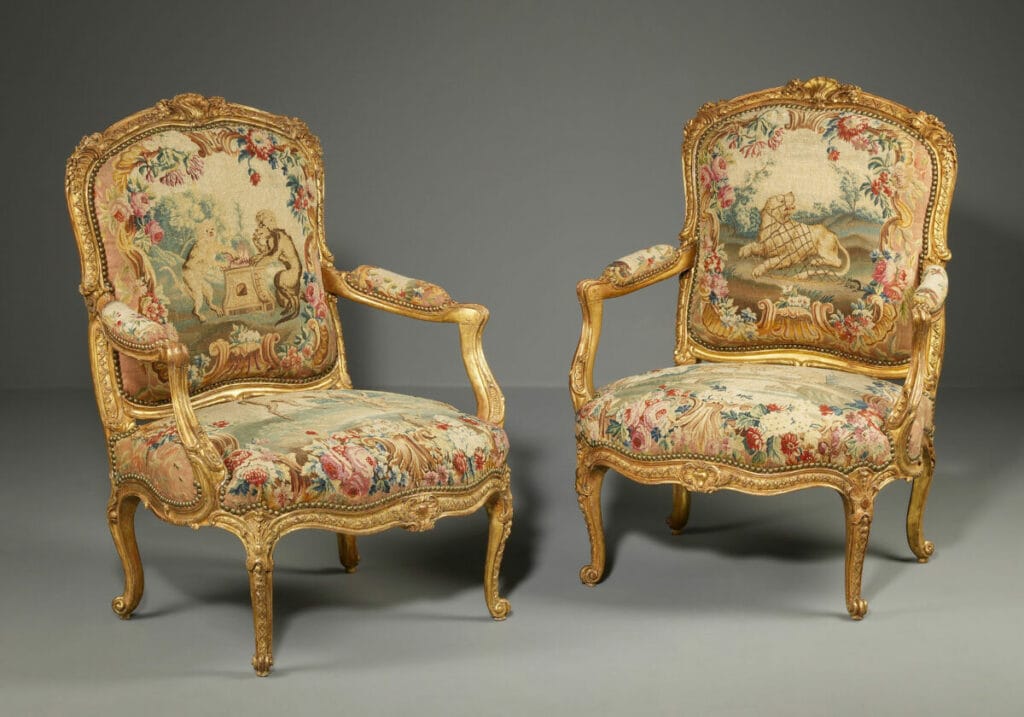
The Cabriolet Armchair: Revolutionary Comfort
True revolution of comfort around 1740, the cabriolet armchair is distinguished by its curved backrest that hugs the shape of the back. Smaller and lighter than its “à la reine” counterpart, it becomes the preferred seat for intimate conversation, easily movable according to the needs of new sociability.
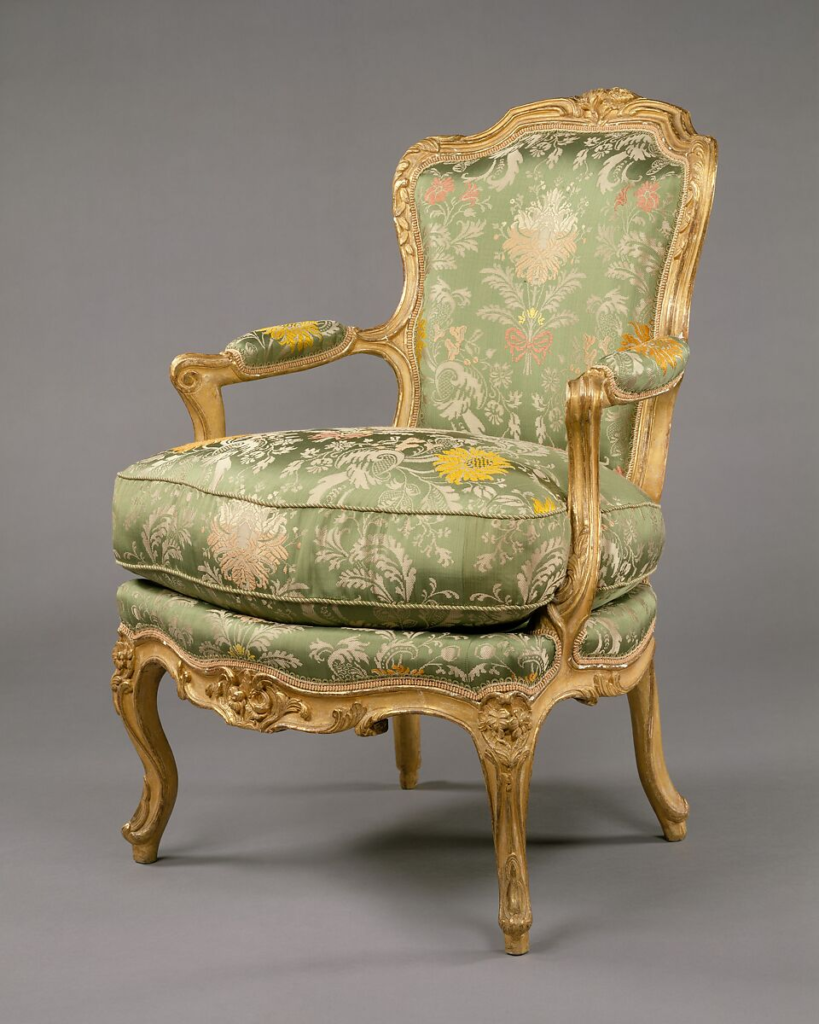
The Marquise: Intimate Luxury
Often confused with the ottoman, the marquise is a small sofa designed for one person. Wider than an armchair but smaller than a traditional sofa, this seat embodies intimacy and personal luxury. Its size allowed one to lie down casually in the more restricted setting of boudoirs or ladies’ salons, making it a private and elegant piece of furniture.

The Duchesse and Duchesse Brisée: Modular Ingenuity
The duchesse brisée is the perfect illustration of the ingenuity and taste for versatile comfort of the era. This resting seat is composed of several parts, generally an armchair and one or more footrests, which can be assembled to form a meridienne or used separately. This flexibility made it indispensable for moments of relaxation, allowing adaptation to desires and spaces.
The Ottoman: Exoticism and Letting Go
The ottoman reflects the era’s craze for oriental influences. This large sofa without backrest or armrests is often entirely padded. Its oriental inspiration made it an invitation to relaxation, far from the constraints of etiquette. It was a piece of furniture for conversation and rest, symbolizing a taste for elsewhere and absolute comfort.
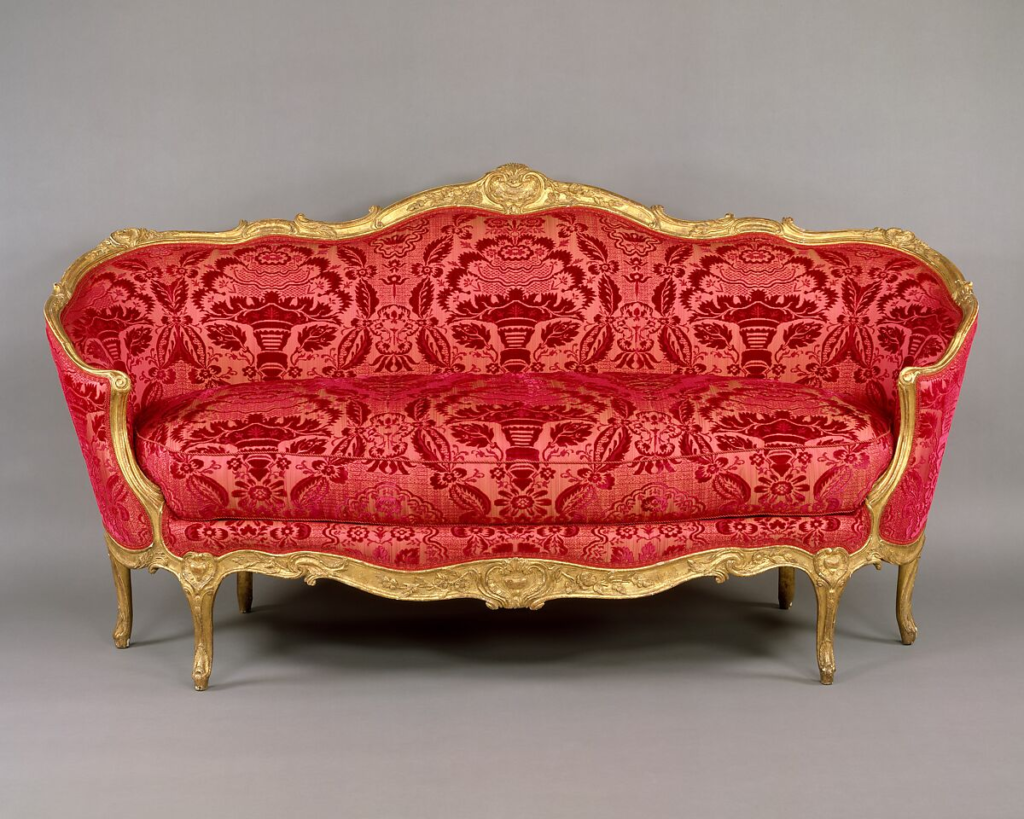
The Voyeuse & The Voyelle: The Seat of Gaming and Observation
These two seats are witnesses to high society entertainment, particularly card games. The voyeuse was intended for the observer: its low backrest with a cushion at the top allowed one to kneel to observe the game without being seen. The voyelle, on the other hand, was the player’s seat, who sat astride, the padded backrest serving as an armrest to rest the arms. It is the symbol of extreme refinement, some models even integrating discreet ashtrays.
Functional Furniture: Innovation and Refinement
Domestic revolution: The Louis XV style invents specialized furniture that transforms the habitat into a theater of refined art of living.
This functional revolution reflects the accelerated evolution of social uses and the emergence of the Parisian bourgeoisie.
Secret furniture multiplies, testifying to the intimization of domestic space and new rituals of private life. Ladies’ furniture elegantly integrates feminine activities (writing, reading, toilette) into exceptional decorative caskets.

Tables: Sculpting Elegance
The Louis XV table revolutionizes the art of tablework by privileging decorative grace and precious materials.
Storage: Intimate Architecture
The Louis XV style transforms storage furniture into decorative elements that simultaneously structure and beautify intimate space. Secretaries adopt refined compositions, often punctuated by secret mechanisms and precious marquetries. Commodes develop a formal vocabulary of remarkable ornamental grace, adorned with rococo bronzes of exceptional fineness.

Night Furniture: Refined Intimacy
The Louis XV style revolutionizes bedroom furniture by creating ensembles of new grace and sensuality.
Nightstands, chiffoniers and secretaries form coherent ensembles that transform the bedroom into a boudoir of intimacy.
The modern bed abandons architecture to adopt sculptural forms, often enhanced with precious fabrics.

Lighting: Sculpting Delicacy
The Louis XV style revolutionizes the art of lighting by creating luminaires that become true decorative sculptures.
The creations of Jacques Caffieri, Philippe Caffieri and Pierre Gouthière transform artificial lighting into graceful spectacle.
The Virtuosos of Louis XV Style
The Louis XV style reveals an exceptional generation of creators who definitively revolutionize Western art and establish new European aesthetic standards.
Charles Cressent: The Master of Rococo Cabinetmaking
Charles Cressent (1685-1768) embodies the perfection of French cabinetmaking and brings the art of furniture to its technical and aesthetic apogee.
His genius lies in his ability to synthesize French tradition and rococo innovations in creations of unequaled grace.
The Cressent workshop revolutionizes cabinetmaking by eliminating visible crossbars and develops unprecedented techniques that durably influence European art.
His creations for European aristocracy definitively establish French supremacy in the art of luxury furniture.
Jean-François Oeben: The Inventor of Mechanism Furniture
Jean-François Oeben (1721-1763) revolutionizes the art of furniture by inventing secret mechanisms, aesthetic of revolutionary ingenuity.
His philosophy of “functional beauty” profoundly influences European art of living and still inspires current creators.
His collaborations with clockmakers create furniture of unique technical sophistication and decorative poetry.
Juste-Aurèle Meissonnier: The Architect of Rococo
Juste-Aurèle Meissonnier (1695-1750) transforms ornamentation into the art of asymmetry and imposes France as a worldwide reference in decorative art.
His ornamental innovations revolutionize decorative art and allow creations of unequaled freedom and grace.
European commissions (German courts, Italian palaces) spread French excellence on all continents.
Masters of Decorative Arts
The Sèvres Manufactory revolutionizes the art of porcelain by developing colorist techniques that transform ceramics into precious art.
Its innovations (turquoise blue, Pompadour pink) transform porcelain into major art and influence all European industry.
Jacques Caffieri develops an art of furniture bronze of radical delicacy, while François-Thomas Germain explores the potentials of rococo goldsmithery.
The Louis XV Market: Between Refinement and Collection
Iconic Pieces and French Elegance
The Louis XV market reveals a clear segmentation between cabinetmaking masterpieces and decorative creations. This typological richness allows diversified access to French rococo aesthetics.

The Collector’s Grail:
Pieces stamped by master cabinetmakers (1730-1770) reach peaks during international auction sales. Records concern mechanism furniture and exceptional marquetries.
Charles Cressent stamped commodes are traded between €200,000 and €1,200,000 depending on the quality of bronzes and state of conservation. Pieces with aristocratic provenance regularly exceed €800,000.
Jean-François Oeben mechanism secretaries vary from €300,000 to €1,500,000, while documented royal pieces can reach €2,000,000.
French Market: Heritage and Savoir-Faire
Specialized Parisian Galleries:
Galerie Steinitz (Saint-Germain): worldwide reference for 18th-century French cabinetmaking. Stamped furniture: €80,000 to €800,000.
Galerie Gismondi (7th): specialist in Louis XV decorative arts. Rococo art objects: €5,000 to €150,000 depending on pieces.
Galerie Nicolas Lenté: expert in French period furniture. Stamped Louis XV seating: €15,000 to €120,000.
French Secondhand Market:
Artcurial, Sotheby’s and Christie’s Paris sales reveal a dynamic French market for stamped furniture.
Beaussant Lefèvre: general sales with Louis XV furniture from €3,000.
Binoche et Giquello: recognized expertise for 18th-century decorative arts, discoveries between €2,000 and €60,000.
International Market: Influence of French Taste
Europe – Rococo Influence:
London maintains a prestige market for French period furniture.
Bonhams and Sotheby’s London: French Furniture departments with expert knowledge.
London Price Ranges:
- Stamped Louis XV bergère: £12,000 to £80,000
- Period commode without stamp: £25,000 to £150,000
- Period Sèvres porcelain: £8,000 to £120,000
United States – Passionate Collectors:
New York concentrates exceptional collections of 18th-century French art.
Christie’s and Sotheby’s NYC: world records for Cressent and Oeben pieces.
European Market: International Taste
Germany – Heritage of Courts:
Munich and Dresden preserve important French rococo collections.
German Market:
- French rococo furniture: €20,000 to €200,000
- Caffieri furniture bronzes: €15,000 to €100,000
- Period flower marquetry: €30,000 to €180,000
Italian Market:
- French rococo influence: inspired Venetian furniture: €15,000 to €80,000
Reproductions and Contemporary Market
Traditional Workshops:
Ateliers d’Art de France maintains certain rococo cabinetmaking traditions with contemporary creations inspired by Louis XV.
Specialized Artisans:
Atelier Hervé Gicquel: faithful reproduction of Louis XV furniture. Cressent-style commode: €25,000 to €60,000.
Ébénisterie Thierry Rousseau: specialist in Oeben mechanisms. Secretary with mechanisms: €40,000 to €80,000.
Style Market:
Quality 19th-century reproductions (Napoleon III period) are traded at €3,000 to €25,000 depending on execution.
Contemporary copies vary from €1,500 to €12,000 but without heritage value.
Expertise and Authentication
Authenticity Criteria:
The stamp of master cabinetmakers is crucial: Cressent, Oeben, Dubois, B.V.R.B (Bernard Van Riesen Burgh).
Period species reveal authenticity: rosewood, violet wood, amaranth massively used in the 18th century.
Rococo bronzes are distinguished by their cold chasing and period mercury gilding.
Specialized Expertise:
Institut National du Patrimoine: specialized training in 18th-century French furniture.
Approved experts Compagnie Nationale des Experts: authentication of major pieces.
Investment and Capital Gains
Price Evolution (2010-2024):
Reference pieces have seen their value multiplied by 1.8 to 4 in fifteen years.
Museum-quality Cressent commode: €400,000 in 2010, €800,000 in 2024.
Stamped period bergère: €18,000 in 2010, €45,000 in 2024.
Investment Criteria:
Stamp and documentation: stamped pieces systematically outperform.
Quality of execution: exceptional marquetries and fine bronzes multiply value.
State of conservation: documented restorations preserve value better than heavy interventions.
Prospects 2025-2030:
Experts anticipate moderate growth due to the scarcity of first-rate pieces.
Emerging Asian demand could revive certain segments (porcelains, art objects).
Second-tier stamped seating still offers interesting appreciation potential.
Specialized Restoration: Call on Artisans with Exceptional Savoir-Faire
Louis XV furniture restoration mobilizes ultra-specialized artisans in rococo techniques:
Cabinetmaker-restorers: Master flower marquetry, 18th-century species (rosewood, violet) and Oeben mechanisms. INMA and Compagnonnage training.
Art bronze workers: Experts in rococo chasing, mercury gilding and period patinas. Workshops: Fonderie Coubertin, Maison Baguès.
Seat upholsterers: Restore traditional upholstery (horsehair, straps) and 18th-century techniques. École Boulle trains these specialists.
Average cost: €8,000 to €50,000 depending on complexity. Delays: 4 months to 18 months for mechanisms.
Louis XV Today: A Living Heritage
Contemporary Renaissance
Far from being a frozen historical style, Louis XV powerfully nourishes contemporary creation and inspires the most refined designers.
Its fundamental lesson – reconciling beauty and comfort, tradition and innovation – resonates strongly in our era of seeking well-being.
The Louis XV approach remarkably anticipates the issues of contemporary design: ergonomics, personalization, art of living.
Influence on Contemporary Design
If Louis XV still inspires certain contemporary creators, its influence remains primarily concentrated on luxury residential codes and prestige hospitality.
Great decorators (Jacques Grange, François Catroux) occasionally draw from this heritage for exceptional projects, while certain houses (Hermès Maison, Christofle) revisit its codes for event collections.
This influence remains however limited by the evolution of contemporary lifestyles, privileging refinement and functionality over rococo ornamentation.
Decorating with Louis XV Style Today
Integrating Louis XV Heritage: Grace and Modernity
Contemporary integration of Louis XV requires subtlety and parsimony to avoid the “marquise boudoir” effect.
Selective approach: A period bergère in a refined contemporary salon brings a note of French grace without decorative overload.
Adapted color codes: Pompadour pinks and blues are updated in powdered tones and bluish grays, more compatible with contemporary aesthetics.
Modern lighting: Integrated LEDs reveal marquetries better than period candles, while preserving rococo intimacy.
Errors to avoid: Proliferation of curves, associations with other loaded styles, poor quality reproductions.

Louis XV: A Heritage for the Future
More than a historical style, Louis XV constitutes a living heritage that continues to enrich our visual culture and inspires 21st-century creators.
Its capacity to reconcile artisanal tradition and decorative innovation, refinement and functionality makes it a particularly current model.
Louis XV teaches us that French elegance is born from the intelligent synthesis between traditional savoir-faire and the search for comfort, between technical excellence and art of living.
This lesson resonates strongly in our era where design seeks to reconcile contemporary innovation and respect for traditions, technical performance and quality of life.
What Decorative Movement After Louis XV?
After the Louis XV style (1723-1774), several movements and styles develop in reaction or continuity:
Styles that directly succeed Louis XV:
1. Transition (1750-1770) 🇫🇷
Country: France (progressive evolution)
Characteristics: Timid return to straight lines, subdued rococo, first antique influences
Figures: Jean-François Oeben, Roger Vandercruse, Pierre Roussel
2. Louis XVI (1774-1792) 🇫🇷
Country: France (neoclassical revolution)
Characteristics: Straight lines, antique inspiration, fluting, garlands
Figures: Georges Jacob, Jean-Henri Riesener, Pierre Gouthière
3. International Neoclassical Style (1760-1840) 🇪🇺
Country: Europe (England, Italy, Russia)
Characteristics: Return to antiquity, classical grandeur, rediscovered symmetry
Figures: Robert Adam, Angelica Kauffmann, Cameron Charles
4. Directoire Style (1795-1804) 🇫🇷
Country: France (Republic and Consulate)
Characteristics: Republican simplicity, antique references, solid mahogany
Figures: Charles Percier, Pierre Fontaine, Georges Jacob
Resources
Design Fundamentals
History of Design & Decorative Styles
From baroque salons to the radical lines of the 20th century, this chronological timeline highlights the aesthetic revolutions that have marked our daily environment.
Read the page “History of Design & Decorative Styles”Hart Design Glossary from A to Z
Sabre legs, patina, passementerie, caning… This lexicon gives meaning to the technical and stylistic terms often used in the design world.
Access the Hart Design GlossaryHart Glossary of Design Icons
This glossary lists all the great names in design and decoration in alphabetical order. Discover the creators who have shaped contemporary living art.
Access the Hart Glossary of Design Icons
Digital entrepreneur and craft artisan, I use my unconventional background to share my vision of luxury design and interior decoration — one enriched by craftsmanship, history, and contemporary creation. Since 2012, I have been working daily in my workshop on the shores of Lake Annecy, creating bespoke interiors for discerning decorators and private clients.

